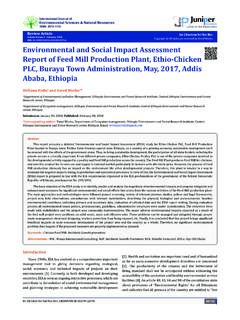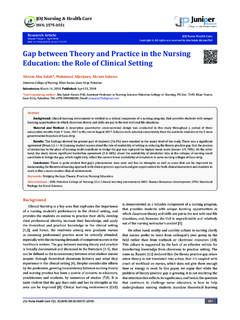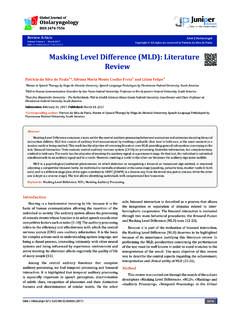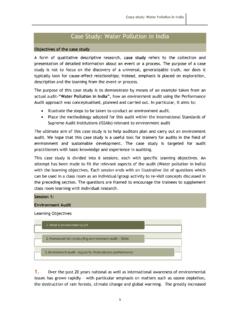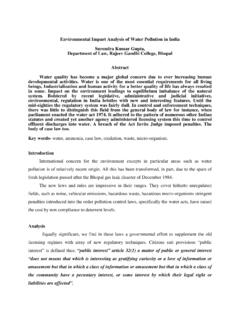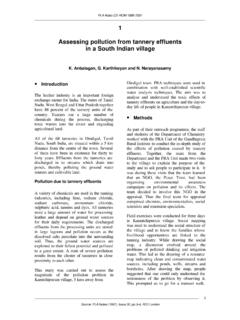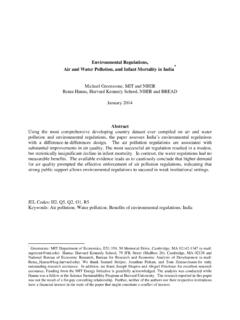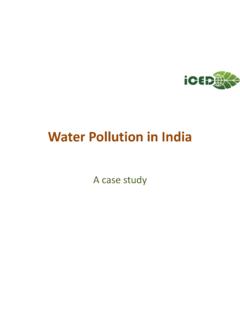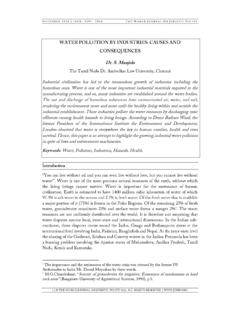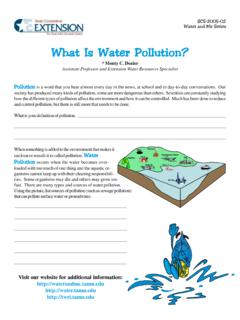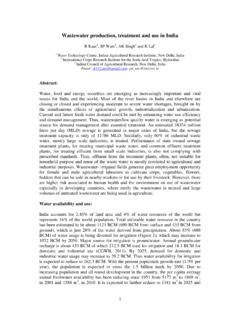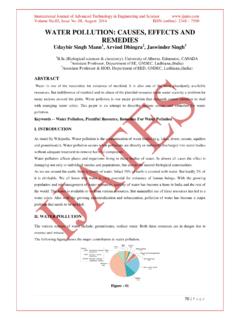Transcription of Review of Hussain Sagar Lake Pollution, Hyderabad, India
1 Review of Hussain Sagar Lake pollution , Hyderabad, IndiaP Mahammed Rafi*1 and Acharya Jyothi Kusuma21 Assistance Professor, Mallareddy Institute of Technology and Sciences, Hyderabad, India2 Associate Professor, Mallareddy Institute of Technology and Technology, Hyderabad, IndiaSubmission: March 21, 2018; Published: April 18, 2018*Corresponding author: P Mahammed Rafi, Assistance Professor, Mallareddy Institute of Technology And Sciences, Hyderabad, India , Email: IntroductionLakes are one of the surface water sources for the human needs, and they are most useful for developmental activities in and around the areas where they existed, they serve infiltration source for ground water , for recharge of water to the water table, in addition to these, lakes can receive domestic sewage and industrial effluents from the catchment area they existed and turn into disposal sites for waste water .
2 In contrast to the perennial flowing water bodies like streams and rivers, mostly the natural lakes are formed at mountain areas, where as the artificial lakes are also constructed in and around the cities to meet the water demand of that particular area, and also to serve wastewater basins for the catchment area they existed. Lakes can retain the waste materials without disturbing ecosystem up to certain extent, but when the discharging wastewater loads increasing, they will lose the ability of self purification process. Due to rapid industrialization and population growth, the requirement of water being increased at alarming rate in order to meet the water requirements of future generation, there is great need of protecting water bodies to promote sustainable development [1]. Many Rivers and natural water bodies across the world are being polluted by domestic and industrial sewage due to a wide range of pollutants.
3 Some of the pollutants are persistent and stable environmental contaminants [2]. Domestic sewage poses health related issues while industrial effluents carry a wide variety of toxic elements like Cd, Cr, Pb, Hg and Zn which can cause significant toxicity even in trace amounts. The pollutants enter various parts of environment by anthropogenic activities as well as natural processes and degrade the surface and ground water quality and make them unsuitable for drinking, industrial, irrigation, recreation or other purposes [3,4]. water bodies in flowing state normally have the capacities to purify itself from the contamination of external sources discharge into the river [5,6]. Self-purification of water is a tedious process involving physical, chemical and biological processes that occur simultaneously, allows lakes to restore its natural state over a certain period [7,8].
4 The process of purification is mainly depends on absorption and dissolution of atmospheric oxygen from the water body surface. This absorbed and dissolved oxygen (DO) is necessary for the growth of bacteria to break down the organic and inorganic pollutants thereby reducing its strength for a period of time [9]. Self-purification capacity of water bodies is mainly depends on natural factors. These include the water velocity, depth, discharge and temperature [10]. The turbulent of water bodies helps the river to very clean because of the natural Int J Environ Sci Nat Res 10(1): (2018)0019 Abstract Hussain Sagar lake, a historical lake which was built in 1562 by Hussain Shaw Wali is situated in the heart of Hyderabad city, India . Earlier up to 1930 s, it was the major water source to meet drinking and irrigation requirements for both twin cities of Hyderabad and Secunderabad.
5 Now this lake turned to virtual garbage bin with no adequate treatment for wastewater loads originated from point and non point sources. Therefore the lake loses the capability of self purification system which was an important factor that depends on the maximum uptake of oxygen from the atmosphere. Multiple projects were undertaken by the concerned authorities for the improvement of Hussain Sagar lake and its catchment area. Recently With referring to the Lake health status, In 2006, HMDA, a governing body set up by Andhra Pradesh Government, initiated Hussainsagar Lake and Catchment Area Improvement project and set up STPs and wastewater interception and diversion structures. It also installed fountains to aerate the lake to improve its water quality as well as to add beauty. But these measures are lying ineffective to manage wastewater paper discusses that the Hussain Sagar lake water body over decades, has been polluted adversely from discharging of organic and inorganic pollutants through open drains as well as point and non point sources and also presents various measures had taken to rejuvenate Hussain Sagar Lake to its past : Hussain Sagar Lake; Oxygen Uptake; Self Purification Capacity; Organic PollutantsResearch ArticleVolume 10 Issue 1 - April 2018 DOI: J Environ Sci Nat ResCopyright All rights are reserved by P Mahammed RafiHow to cite this article: P M Rafi, Acharya J K.
6 Review of Hussain Sagar Lake pollution , Hyderabad, India . Int J Environ Sci Nat Res. 2018; 10(1): 555778. DOI: Journal of Environmental Sciences & Natural Resourcescapacity to absorb and digest pollutants at a very high rate. Stagnant water bodies tend to become septic because of the low rate of oxygen absorption. Furthermore, the depth of the water body also affects the rate of diffusion and mixing of the absorbed oxygen [11]. The temperature of water is high; low DO concentration because biological and chemical activity increases [12]. At a certain temperature the saturated dissolved oxygen is the maximum DO level that a river can attain. Maximum DO ranges from mg/L of DO at 00C to mg/L at 350C [13]. Hussain Sagar Lake Hussain Sagar Lake was built in 1562 during the reign of the Qutb Shahi dynasty at Golkonda fort as shown in Figure 1.
7 It is an artificial lake built on a tributary of River Musi. The lake joins the cities of Hyderabad and Secunderabad besides adding an aesthetic appeal to the twin cities. The lake water was utilized for irrigation and drinking water needs from 1884 to 1930. The total catchment area of the lake is 240 square kilometres (93 sq mi). Through four main feeder nalas named Picket Nala, Kukatpally Nala, Banjara Nala and Balkapur Nalla, wastewater from the catchment area reaches the lake. Till 1930s, the lake was the major source of water supply to the population of Hyderabad and later on it turns into wastewater basin as the lake has gradually started receiving sewage and industrial effluents through the feeder nallas. The Picket Nalla discharges mostly domestic sewage throughout the year into the lake from the north-eastern side. Similarly the Banjara Nalla (from north-western side) and Balkapur Nalla (from western side) discharge mostly domestic sewage into the lake.
8 The Kukatpally Nalla was seen to be discharging a mix of domestic sewage and industrial effluents into the lake from the northern side. This practice of discharging municipal sewage, industry effluents and storm- water from over 240 square kilometres increased the content of organic matter, nitrogen and phosphorus. This suspended organic matter, rich in nutrients, caused eutrophication that allowed growth of algal blooms and water hyacinth [14].Figure 1: Satellite image of Hussain Sagar lake is mainly fed largely by the Kukatpally nala, which contributes domestic and industrial effluents from the Kukatpally industrial area while other nalas discharges domestic sewage flows only as shown in Table 1. Thus the water quality of the lake deteriorating due to the inflow of polluted water into the Hussain Sagar Lake. Table 1: In flows of domestic sewage and Industrial of the NalaDomestic Flow, MLDI ndustrial Flow, MLDT otal flow, MLDR emarksKukatpally nala551570 Interception and diversion (I&D)Picket nala6---6 Interception and diversion after pumping, Proposed STP (30 MLD capacity)Banjara nala6---6 Interception and diversion (I&D)Balkapur nala13---13 STP (20 MLD capacity)Total80159550 MLD Treatment by Two STPsHow to cite this article: P M Rafi, Acharya J K.
9 Review of Hussain Sagar Lake pollution , Hyderabad, India . Int J Environ Sci Nat Res. 2018; 10(1): 555778. DOI: Journal of Environmental Sciences & Natural ResourcesLiterature ReviewThe immersion of Ganesh idols in the lake every year has made it worse. It was reported that the water quality of Hussain Sagar Lake is deteriorated with many heavy metals concentration in elevated levels than the ICMR standards [15]. It has also been reported that the kukatpally nallah carries the major quantity of pollutants which was determined by the sediment analysis at kukatpally nalla being heavily polluted by potentially toxic elements (PETs) [16]. Besides adding silt, studies indicate that these immersions have increased the pollution levels in the lake. The sediment and pore water analysis has shown elevated concentration of Cr & Pb indicating settlement of various pollutants at bottom of lake [17].
10 All lakes serve to recharge the water table. But because of heavy pollution of Hussain Sagar Lake, many of pollutants get carried into underground water bodies. Though percolation filters many pollutants, open wells or bore wells receive certain pollutants causing ground water pollution . Elevated levels of certain chemicals like Hg, Cd, Pb & Ni have been reported around Hussain Sagar lake [18]. Cleaning the Hussain Sagar Lake Programme To address the lake water quality, Hyderabad Metropolitan Development Authority (HMDA) has made efforts to restore a highly polluted Hussain Sagar Lake to its pristine glory. The project entitled Hussainsagar Lake and catchment area improvement project which initiated in March 2006, aims at improving lake water quality by preventing entry of pollutants into lake from both point and non-point sources of pollution , besides removal of nutrient rich sediment.
